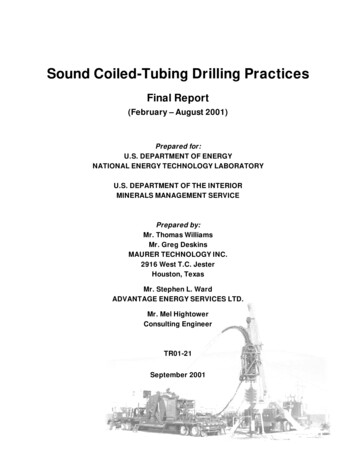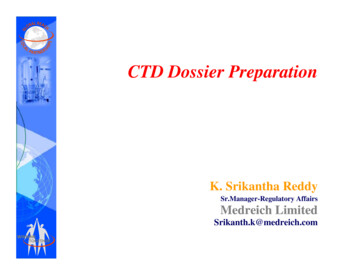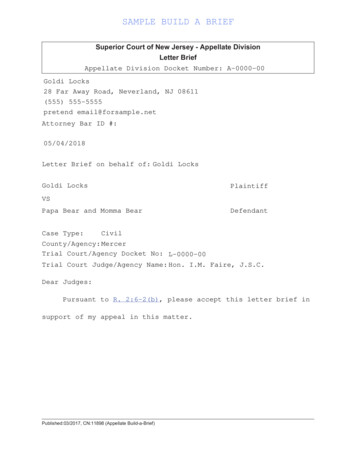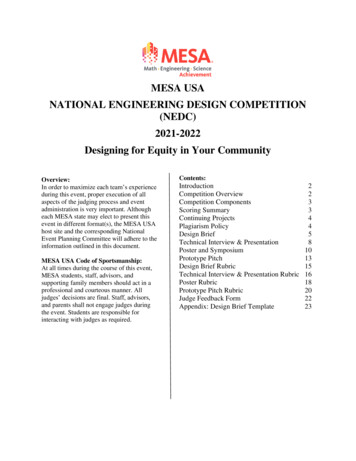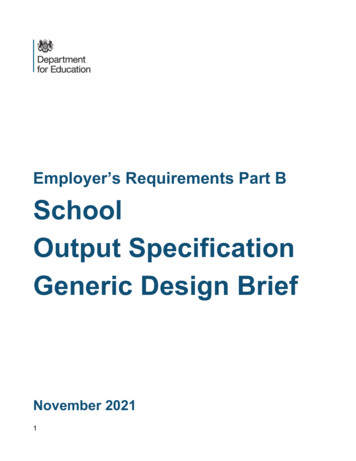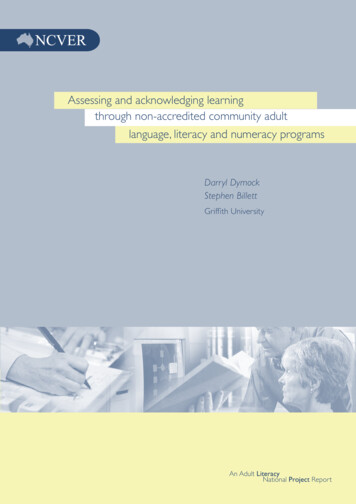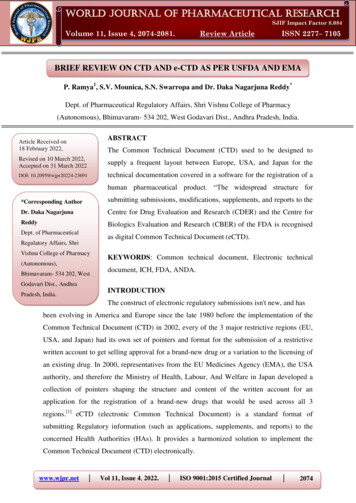
Transcription
World Journal of Pharmaceutical ResearchWorld Journal of PharmaceuticalResearchSJIF ImpactFactor 8.084Reddy et al.Volume 11, Issue 4, 2074-2081.Review ArticleISSN 2277– 7105BRIEF REVIEW ON CTD AND e-CTD AS PER USFDA AND EMAP. Ramya1, S.V. Mounica, S.N. Swarropa and Dr. Daka Nagarjuna Reddy*Dept. of Pharmaceutical Regulatory Affairs, Shri Vishnu College of Pharmacy(Autonomous), Bhimavaram- 534 202, West Godavari Dist., Andhra Pradesh, India.ABSTRACTArticle Received on18 February 2022,The Common Technical Document (CTD) used to be designed toRevised on 10 March 2022,Accepted on 31 March 2022supply a frequent layout between Europe, USA, and Japan for theDOI: 10.20959/wjpr20224-23691technical documentation covered in a software for the registration of ahuman pharmaceutical product. “The widespread structure for*Corresponding Authorsubmitting submissions, modifications, supplements, and reports to theDr. Daka NagarjunaCentre for Drug Evaluation and Research (CDER) and the Centre forReddyBiologics Evaluation and Research (CBER) of the FDA is recognisedDept. of Pharmaceuticalas digital Common Technical Document (eCTD).Regulatory Affairs, ShriVishnu College of PharmacyKEYWORDS: Common technical document, Electronic technical(Autonomous),Bhimavaram- 534 202, Westdocument, ICH, FDA, ANDA.Godavari Dist., AndhraINTRODUCTIONPradesh, India.The construct of electronic regulatory submissions isn't new, and hasbeen evolving in America and Europe since the late 1980 before the implementation of theCommon Technical Document (CTD) in 2002, every of the 3 major restrictive regions (EU,USA, and Japan) had its own set of pointers and format for the submission of a restrictivewritten account to get selling approval for a brand-new drug or a variation to the licensing ofan existing drug. In 2000, representatives from the EU Medicines Agency (EMA), the USAauthority, and therefore the Ministry of Health, Labour, And Welfare in Japan developed acollection of pointers shaping the structure and content of the written account for anapplication for the registration of a brand-new drugs that would be used across all 3regions.[1] eCTD (electronic Common Technical Document) is a standard format ofsubmitting Regulatory information (such as applications, supplements, and reports) to theconcerned Health Authorities (HAs). It provides a harmonized solution to implement theCommon Technical Document (CTD) electronically.www.wjpr.net Vol 11, Issue 4, 2022. ISO 9001:2015 Certified Journal 2074
Reddy et al.World Journal of Pharmaceutical ResearchAn eCTD consists of individual documents in PDF format which are arranged in ahierarchical form as per the CTD structure. It also has an XML backbone which cross-linksrequired documents and provides information regarding the submission. The purpose ofintroducing eCTD was to reduce the burden on the reviewers of the has. It also simplifies theprocess of submission as all the Regulatory authorities use it as a standard format. Thismodule-based regulatory application format was developed by the International Conferenceon Harmonization (ICH M2 EWG). In 2008 the FDA (Food and Drug Administration) madeeCTD format compulsory for all electronic submissions by FDA in 2008.[2]SignificanceIt provides appropriate format data which is easy to understand and helps in evaluation ofdata.CTD is relevant to all types of products.It is extra format that helps in simpler evaluation for reviewer also.CTD additionally helps in simultaneous submission of archives for approval in 3 regions andhelps trade of regulatory information. Moreover, it allows electronic submissions and fasteravailability of new drug treatments to patient populations.[3]RESULTSORGANISATION OF THE COMMON TECHNICAL DOCUMENT IN USThe Common Technical Document is prepared into 5 modules. Module 1 is location specific.Modules 2, 3, 4, and 5 are supposed to be frequent for all regions. Conformance with thisguideline should ensure that these four modules are furnished in a layout proper to theregulatory authorities.Module 1: Administrative Information and Prescribing InformationThis module contain documents unique to every region; for example, application types or theproposed label for use in the region. The content material and layout of this module can beprecise by means of the applicable regulatory authorities.Module 2: Common Technical Document SummariesModule 2 should begin with a general introduction to the pharmaceutical, such as itspharmacologic class, mode of action, and proposed clinical use. In general, the Introductionneed to no longer exceed one page.www.wjpr.net Vol 11, Issue 4, 2022. ISO 9001:2015 Certified Journal 2075
Reddy et al.World Journal of Pharmaceutical ResearchModule 2 should contain 7 sections.1. CTD Table of Contents2. CTD Introduction3. Quality Overall Summary4. Nonclinical Overview5. Clinical Overview6. Nonclinical Written and Tabulated Summaries7. Clinical SummaryThe organisation of these summaries is described in Guidelines for M4Q, M4S, and M4E.[4]Module 3: QualityInformation on Quality should be presented in the structured format described in the M4Qguidance.Module 4: Nonclinical Study ReportsThe nonclinical study reports should be presented in the order described in the M4Sguidance.Module 5: Clinical Study ReportsThe human study reports and related information should be presented in the order describedin the M4E guidance.[4]Organisation of the common technical document in EUThe Common Technical Documentation organized into five modules. Module one is spacespecific. Modules 2, 3, 4, and five area unit meant to be frequent for all regions. Conformitywith this guideline make certain that these four modules area unit equipped in an exceedinglyformat applicable to the restrictive authorities.Module 1: Administrative Information and Prescribing InformationModule have to be compelled to documents specific to every region; for instance, applicationforms or the planned label to be used within the region. The content material and format ofthis module is specific by suggests that of the applicable regulative authorities.www.wjpr.net Vol 11, Issue 4, 2022. ISO 9001:2015 Certified Journal 2076
Reddy et al.World Journal of Pharmaceutical ResearchModule 2: Common Technical Document SummariesModule a pair of got to begin with an established introduction to the pharmaceutical,alongside its pharmacological category, mode of action, and projected clinical use. In general,the Introduction should not exceed one page.Module 2 should contain 7 sections in the following order.1. CTD Table of Contents2. CTD Introduction3. Quality Overall Summary4. Nonclinical Overview5. Clinical Overview6. Nonclinical Written and Tabulated Summaries7. Clinical SummaryThe organisation of these summaries is described in Guidelines for M4Q, M4S, and M4E.Module 3: Quality information on Quality should be given within the structured formatrepresented in Guideline M4Q.Module 4: Nonclinical Study Reports The nonclinical study reports should to be given withinthe order represented in Guideline M4S.Module 5: Clinical Study Reports The human study reports and connected informationshould be given within the order represented in Guideline M4E.[5]The primary technical components are. A high-level folder structure (required) An Extensible Mark-up Language (XML) backbone file which provides metadata aboutcontent files and lifecycle instructions for the receiving system. An optional lower level folder structure (recommended folder names are provided inrespective modules of the eCTD specification below) Associated document type definitions (DTDs) and style sheets that support the presentationand navigation.[1]ORGANISATION OF THE ELECTRONIC COMMON TECHNICAL DOCUMENTIN USIt contains 5 modules.Module 1: Administrative and prescribing informationwww.wjpr.net Vol 11, Issue 4, 2022. ISO 9001:2015 Certified Journal 2077
Reddy et al.World Journal of Pharmaceutical ResearchIt includes, however is not restricted to body, labelling, REMS and message documents. Thetopic matter for every document should be allotted to all times low level of the hierarchyprinted within the associated food and drug administration technical specificationcomprehensive table of contents headings and hierarchy.Module 2: SummariesModule 3: QualityModule 4: NonclinicalThe organization of Module 4 is the same for all applications and related submissions. Theguidance provided below addresses general considerations for the submission contents.Module 5: ClinicalThe organization of Module 5 is the same for all applications and related submissions. Theguidance provided below addresses general considerations for the submission contents (i.e.,the physical files and folders) and the contents of the message.[6]ORGANISATION OF THE ELECTRONIC COMMON TECHNICAL DOCUMENTIN EU.Modules of eCTDThe eCTD has five modules in two categories. There are.1. Regional module which includes only Module 1-Administrative information andprescribing information -not harmonized -different for each region; i.e., country, defined byeach of the ICH regions (USA, Europe and Japan).[7]2. Common modules: which includes module 2 –5(Harmonized -common to all the regions). Module 2 -Common technical document summaries Module 3 -Quality Module 4 -Nonclinical study reports Module 5 -Clinical study reportswww.wjpr.net Vol 11, Issue 4, 2022. ISO 9001:2015 Certified Journal 2078
Reddy et al.World Journal of Pharmaceutical ResearchFigure showing Electronic common technical document.e-CTD submissions are accepted for the following applications. Investigational New Drug (INDs) New Drug Applications (NDAs) Abbreviated New Drug Applications (ANDAs) Biologics License Applications (BLAs) All the applications following the submission of the above-stated applications All the Master Files (MFs) which are part of any above-mentioned applicationsDISCUSSIONComparison of CTD and eCTD in USA and EU.Table 1: Comparison of CTD and eCTD in USA and EU.[8]SR.NO Point to be address1Regulatory authority2Types of Application3Types of registration procedurewww.wjpr.net Vol 11, Issue 4, 2022.USAFood and DrugAdministration3 types:NDAANDABLAThe application isdirectly submit to theFDA or through anyapproved contact agent EUEuropean MedicinesAgencyMAA4 types of registrationprocedure: CP, DCP,MRP and NPISO 9001:2015 Certified Journal 2079
Reddy et al.World Journal of Pharmaceutical Research4Technical data about drugsubstance or APIDrug master file5eCTDeCTD mandatory forall types of application6Drug product labellingPackage inserts areprovidedActive substance MasterFileeCTD not fullymandatory but Nees issubmitted along withpaper submission till2009Summary Of productLabelling7Information about clinicalinvestigatorProvided in module 5Module 18Certificate of suitabilityNot applicableLatest certificate ofsuitability100000 units100000 unitsModule 1Module 1910Batch size for manufacturingand controlBio-waiver request for BA/BECONCLUSIONThe study provides evidence of importance of the CTD comparison with eCTD & the globalregulatory challenges faced by the CTD and eCTD. It is clear that CTD, has helped manycountries like US and EUROPE not only develop their own registration processes but toparticipate more and more in the development of new ICH guidelines.REFERENCE1. Debbie Jordan, An overview of the Common Technical Document (CTD) regulatorydossier, 23.2. MaryAnn Foote, Using the biologic license application or new drug application as a basisfor the common technical document, Biotechnology Annual Review 2004 Elsevier B.V,volume 10 ISSN: 1387-2656.3. Varun Garg1, Shruti Chopra2, Sachin Kumar Singh1, Monica Gulati1*, BimleshKumar1, Neeraj Mittal3, A comparative study of common technical document in differentregulated market, Received on: 17-05-2017; Revised on: 24-06-2017; Accepted on: 0907-2017.4. Nisar Ahammad*, Nagarjuna Reddy, M.V. Nagabhushanam, Brahmaiah Ramakrishna,Challenges Faced During eCTD and CTD Filling Procedures for USFDA and Canada,Journal of Drug Delivery & Therapeutics, 2019; 9(4-s): 673-679.5. M4 Organization of the Common Technical Document for the Registration ofPharmaceuticals for Human Use Guidance for Industry [Accessible ww.wjpr.net Vol 11, Issue 4, 2022. ISO 9001:2015 Certified Journal 2080
Reddy et al.World Journal of Pharmaceutical Research6. Electronic Common Technical Document (eCTD) v4.0 Technical Conformance Guide[Accessible source]: https://www.fda.gov/media/135573/download7. /EU%20M1%20v141 Spec%20 Nov2011 FINAL.pdf8. Singh Satbir*1, Kumar Pankaj1 and Rana Arpana2, Global Regulatory Challenges OFCommon Technical Document, World Journal Of Pharmacy and PharmaceuticalSciences, 6(12): 1298-1309.www.wjpr.net Vol 11, Issue 4, 2022. ISO 9001:2015 Certified Journal 2081
CTD Table of Contents 2. CTD Introduction 3. Quality Overall Summary 4. Nonclinical Overview 5. Clinical Overview 6. Nonclinical Written and Tabulated Summaries 7. . Comparison of CTD and eCTD in USA and EU. Table 1: Comparison of CTD and eCTD in USA and EU.[8] SR.NO Point to be address USA EU 1 Regulatory authority Food and Drug
